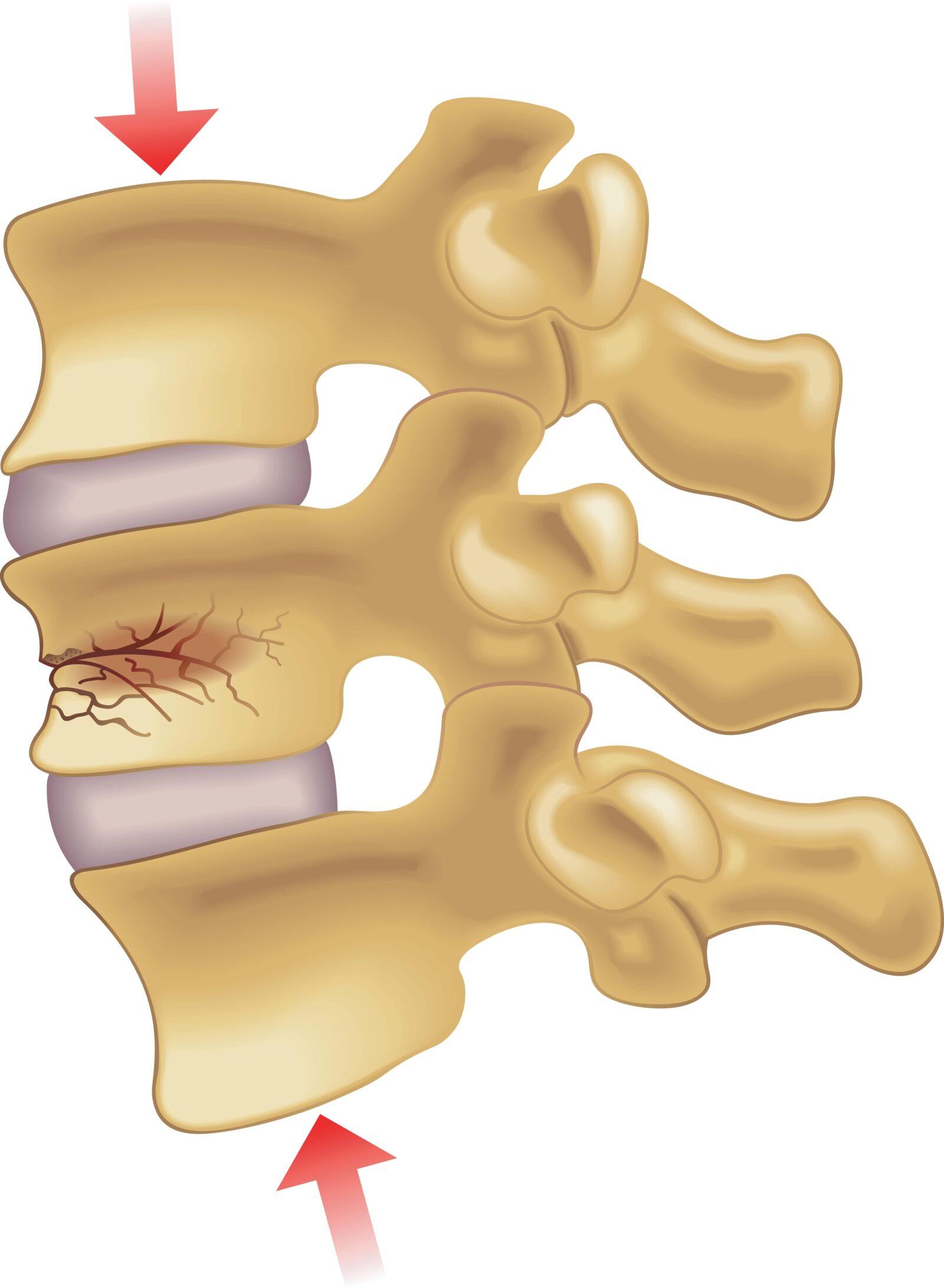Obesity is a growing global health concern that significantly impacts various aspects of physical well-being, including spinal health. The spine, a crucial structure in the human body, supports and facilitates our movements, and is essential for overall body function. However, the excessive body weight associated with obesity places undue stress on the spinal column, leading to a range of complications. This blog will explore the intricate relationship between obesity and spinal health, shedding light on the mechanical, metabolic, and postural challenges that excess weight imposes on the spine. By understanding the risks and identifying the preventative and management strategies, individuals can take proactive steps towards maintaining a healthy spine, thereby enhancing their quality of life.
In This Blog:
- The Anatomy of the Spine
- How Obesity Affects the Spine
- Secondary Health Conditions Related to Obesity and Spine Health
- Preventing and Managing Spinal Health Issues in Obese Individuals
The Anatomy of the Spine
The spine is an intricate structure that plays a critical role in the human body, not only providing support and stability but also allowing for flexibility and movement. Understanding its anatomy is essential to grasp how obesity can affect spinal health.
Structure and Function of the Spine
The human spine is composed of a series of bones called vertebrae, which are stacked upon one another to form the vertebral column. This column is divided into four main regions: the cervical (neck), thoracic (mid-back), lumbar (lower back), and sacral (pelvic) regions. Between the vertebrae are intervertebral discs, which act as cushions and shock absorbers, allowing for movement and flexibility.
The spine serves several crucial functions:
- Support: It bears the weight of the head and torso, providing a central structure for the body.
- Movement: It facilitates motion and flexibility, enabling bending, twisting, and turning movements.
- Protection: The spinal column houses and protects the spinal cord, which is the main pathway for information traveling between the brain and the rest of the body.
- Posture: It is key to maintaining an upright posture, balancing the body in both static and dynamic states.
Role of the Spine in Overall Body Health
The health of the spine is vital for overall well-being. A healthy spine allows for smooth and efficient movement, which is essential for daily activities and physical performance. It also plays a significant role in the nervous system, as the spinal cord is a critical part of the central nervous system, facilitating communication between the brain and the body.
Moreover, spinal health influences other body systems. For example, a misaligned or stressed spine can lead to complications with the digestive and respiratory systems, and even impact mental health due to chronic pain and reduced mobility.
How Obesity Affects the Spine
Obesity exerts a significant impact on spinal health through various mechanisms, leading to increased risks of spinal disorders and complications. Understanding these effects is crucial for managing and preventing spinal health issues in obese individuals.
Increased Weight Impact on Spinal Discs and Vertebrae:

The spine is designed to carry the body’s weight. However, excess body weight from obesity increases the load on the spinal discs and vertebrae, leading to accelerated wear and tear. This extra pressure can cause the discs to degenerate faster than they would in individuals of normal weight, potentially resulting in disc herniation, where the disc bulges or breaks open, causing pain and discomfort.
Risk of Herniated Discs and Compression Fractures:
The added stress from excessive weight can also increase the risk of herniated discs and compression fractures. Herniated discs occur when the inner gel-like material of the disc protrudes through a tear in the outer layer, often compressing nearby nerves and leading to pain, numbness, or weakness. Compression fractures happen when one or more bones in the spine weaken and crumple, which can be more common in obese individuals due to the increased mechanical load.
Fat Tissue and Inflammation:
Adipose tissue, or body fat, is not just a storage medium for energy but also an active endocrine organ that produces hormones and inflammatory substances. In obese individuals, the increased amount of adipose tissue can lead to higher levels of systemic inflammation. This inflammation can affect spinal health by contributing to the degeneration of spinal tissues, including discs and joints, exacerbating pain and dysfunction.
Effects on Bone Health and Spinal Structures:
Obesity can also influence bone metabolism and health. The excessive strain on the spine, coupled with potential inflammatory processes and hormonal changes associated with obesity, can affect the strength and integrity of bones and joints in the spinal column, increasing the risk of osteoporosis and other degenerative bone diseases.
Lumbar Lordosis and Its Effects:
Obesity, especially abdominal obesity, can lead to increased lumbar lordosis, which is an exaggerated inward curve of the lower back. This change in spinal alignment can strain the muscles and ligaments in the back, leading to pain and increased risk of injury.
Altered Walking and Movement Patterns:
The extra weight carried by obese individuals can lead to changes in how they walk and move, often in an attempt to compensate for the increased load. These altered movement patterns can strain the spine and surrounding musculoskeletal structures, leading to pain and mobility issues.
As you can see, obesity significantly affects spinal health through mechanical, metabolic, and postural pathways, leading to a range of potential spinal problems. Addressing these issues requires a holistic approach that includes weight management, physical activity, and, in some cases, medical intervention to alleviate pain and improve function.
Secondary Health Conditions Related to Obesity and Spine Health
Obesity’s impact on the spine can lead to various secondary health conditions that extend beyond the immediate realm of spinal disorders. These conditions often exacerbate the overall health challenges faced by obese individuals and can significantly affect their quality of life.
Chronic Back Pain and Its Consequences
Chronic back pain is one of the most common and debilitating conditions associated with obesity and spinal health. The excess weight increases the strain on the back, leading to wear and tear on the spinal structures and persistent pain. This chronic pain can limit physical activity, contributing to a cycle of weight gain and decreased fitness, further impairing spinal health and overall well-being.
Mobility Restrictions and Loss of Flexibility
Obesity can lead to decreased mobility and flexibility, partly due to the mechanical load on the spine and joints, and also because of the secondary conditions like chronic pain and muscle weakness. Reduced mobility not only affects physical activities but can also interfere with daily tasks and personal care, leading to a decreased quality of life and increased dependency on others.
Association with Other Diseases Like Osteoarthritis and Sciatica
The excessive weight associated with obesity puts additional stress on the joints, including those in the spine, which can accelerate the wear and tear that leads to osteoarthritis. This degenerative joint disease causes the cartilage in the joints to break down, leading to pain, stiffness, and reduced movement. Furthermore, obesity increases the risk of sciatica, a condition where the sciatic nerve is irritated or compressed, typically resulting in pain that radiates from the lower back down to the legs.
The interplay between obesity and spinal health can thus lead to a complex web of health issues, with each condition potentially exacerbating the others. Managing these interconnected health challenges requires a comprehensive approach that addresses both the symptoms and the underlying causes, such as obesity and poor spinal health.
Preventing and Managing Spinal Health Issues in Obese Individuals
Addressing the impact of obesity on spinal health involves a multifaceted approach that includes weight management, medical interventions, and lifestyle modifications. Effective prevention and management strategies are critical for improving quality of life and reducing the risk of long-term complications.
Diet and Nutrition:
Proper nutrition plays a crucial role in weight management and overall health. A balanced diet rich in fruits, vegetables, whole grains, and lean proteins can help reduce body weight and decrease the strain on the spine. Nutritional counseling may be beneficial to help individuals make informed food choices and develop healthy eating habits.

Exercise and Physical Activity:
Regular physical activity is essential for weight loss and maintaining a healthy spine. Exercise helps strengthen the muscles that support the spine, increases flexibility, and can reduce the severity of obesity-related spinal conditions. Tailored exercise programs that consider an individual’s health status and limitations are crucial for effectiveness and safety.
Physical Therapy and Rehabilitation:
Physical therapy can be highly beneficial for individuals suffering from obesity-related spinal issues. It involves customized exercises that strengthen the back, abdominal muscles, and other areas to support the spine, improve posture, and relieve pain. Rehabilitation programs may also include pain management techniques and education on proper body mechanics to prevent further spinal damage.
Surgical Options in Severe Cases:
In cases where conservative treatments are ineffective, and the spinal condition is severe, surgical interventions may be necessary. These can range from minimally invasive procedures to more complex surgeries like spinal fusion or disc replacement. Surgery is typically considered a last resort and must be carefully evaluated against potential risks and benefits.
Ergonomics and Posture Correction:
Educating individuals about proper ergonomics and posture can play a significant role in preventing and managing spinal issues. This includes guidance on how to set up a work environment that minimizes stress on the spine, as well as training in correct posture during daily activities.
Stress Reduction and Mental Health Support:
Chronic pain and mobility issues associated with obesity and spinal health can lead to stress and mental health challenges. Addressing these aspects through stress reduction techniques, counseling, and support groups can improve mental well-being and aid in the overall management of spinal health issues.
Preventing and managing spinal health issues in obese individuals requires a comprehensive approach that addresses the physical, psychological, and lifestyle factors contributing to these conditions. By implementing strategies focused on weight management, medical intervention, and lifestyle changes, individuals can significantly improve their spinal health and overall quality of life.
Conclusion
In conclusion, the impact of obesity on spinal health is a multifaceted issue that requires comprehensive attention and action. The excessive weight associated with obesity places a significant burden on the spine, leading to various mechanical, metabolic, and postural challenges that can exacerbate the risk of spinal disorders and related health conditions. Effective management and prevention strategies, including weight management, physical activity, medical interventions, and lifestyle adjustments, are essential for mitigating these risks and enhancing the quality of life for those affected. By prioritizing spinal health in the context of obesity, individuals and healthcare providers can work together to create a healthier future, emphasizing the importance of a holistic approach to well-being and the interconnected nature of body systems.










